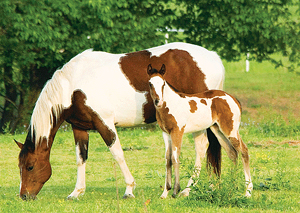
The American Paint Horse is a type of horse has a distincive pattern of white and dark coat colors and looks like a western stock horse. The “Paint Horse” is descended from Spanish horses brought over to the US and was a popular horse with the American Indians who used the American Paint Horse as a war horse. The American Paint Horse is not strictly a separate breed but these days it is treated as one.
The horse must exhibit a “natural paint marking”, meaning either a predominant hair coat color with at least one contrasting area of solid white hair of the required size with some underlying unpigmented skin present on the horse at the time of its birth. Or, in the case of a predominantly white hair coat, at least one contrasting area of the required size of colored hair with some underlying pigmented skin present on the horse.
There is a genetic problem with some paint horses called Overo Lethal White Syndrome (OLWS) When a foal is born that is homozygous for the LWS gene, it will be humanely euthanized shortly after birth, or else will die within a few days from complications involving an underdeveloped intestinal tract.
 From the APHA website:
From the APHA website:
“The American Paint Horse’s combination of color and conformation has made the American Paint Horse Association (APHA) the second-largest breed registry in the United States based on the number of horses registered annually. While the colorful coat pattern is essential to the identity of the breed, American Paint Horses have strict bloodline requirements and a distinctive stock-horse body type. To be eligible for registry, a Paint’s sire and dam must be registered with the American Paint Horse Association, the American Quarter Horse Association, or the Jockey Club (Thoroughbreds). At least one parent must be a registered American Paint Horse. To be eligible for the Regular Registry, the horse must also exhibit a minimum amount of white hair over unpigmented (pink) skin.
“Each Paint Horse has a particular combination of white and any color of the equine spectrum: black, bay, brown, chestnut, dun, grullo, sorrel, palomino, buckskin, gray or roan.
“Markings can be any shape or size, and located virtually anywhere on the Paint’s body.
“Although Paints come in a variety of colors with different markings, there are only three specific coat patterns: overo, tobiano and tovero.
“These colors, markings and patterns, combined with stock-type conformation, athletic ability and agreeable disposition, make the American Paint Horse an investment in quality.”
And Paints are different than Pintos. Wikipedia explains “A Pinto differs from a Paint solely by bloodlines. A Pinto may be of any breed or combination of breeds, though some Pinto registries may have additional restrictions. (Some do not register draft horses or mules, for example.) For a horse to be registered as an American Paint Horse however, it must have registered American Quarter Horse, American Paint Horse, or Thoroughbred parents. Therefore, all Paint horses (except for the small number of “solids” allowed into the Paint registry) could be registered as Pintos, but not all Pintos qualify to be registered as Paints.”
More information can be found at the APHA breed association.
